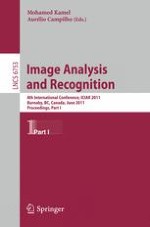The two-volume set LNCS 6753/6754 constitutes the refereed proceedings of the 8th International Conference on Image and Recognition, ICIAR 2011, held in Burnaby, Canada, in June 2011. The 84 revised full papers presented were carefully reviewed and selected from 147 submissions. The papers are organized in topical sections on image and video processing; feature extraction and pattern recognition; computer vision; color, texture, motion and shape; tracking; biomedical image analysis; biometrics; face recognition; image coding, compression and encryption; and applications.
